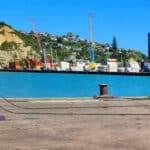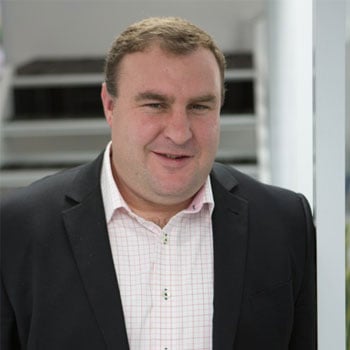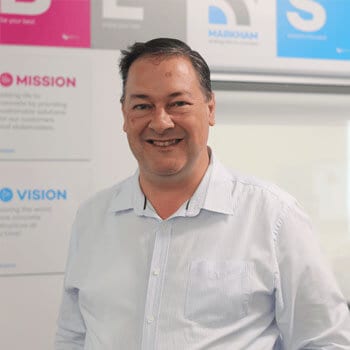Martin talks about Durastruct – its focus and aims, particularly in taking an overall holistic approach to structures. This means not only increasing the design life or reducing maintenance costs, but also using technology and systems out there that can bring the structures into the 21st century. Reducing overall consumption is a practical method of reducing our carbon footprint. Martin also shares insights into their work, partnering with other specialists to reduce concrete deterioration with a novel approach to wastewater infrastructure.
Bringing Structures Into The 21st Century

Invisible Strength
Bringing Structures Into The 21st Century
/
RSS Feed
View the Transcript
BRENDAN: Well, g’day, everybody. Great to have you listening today, and welcome to another segment of MARKHAM’s Invisible Strength – Next Level podcast!
It’s great to have with us today Martin Prestidge from DURASTRUCT. Those of you who know MARKHAM will know that Martin has been formerly on the team, and he’s branched out his own in the infrastructure remediation and maintenance space, which is a fairly high-profile game in some quarters.
Martin, welcome aboard!
MARTIN: Good day, Brendan. Good to see you again. Thanks for having us along.
BRENDAN: Yes, that’s great to have you. Do you want to give us a bit about your background, and what DURASTRUCT is doing out in the field?
MARTIN: Yes, thanks. So as you said, Brendan, I was with MARKHAM for 14 years, so got a good idea of what you’re doing in the space. Yes, we branched out, seven months ago now, and set up a company called DURASTRUCT. The thinking behind it was just to take an overall holistic approach to structures. Not only increasing the design life or reducing maintenance costs but also using technology and systems out there that can bring the structures into the 21st century. So with this day and age, with green and clean, there’s a lot of emphasis on reducing our carbon footprint. But I think the most effective way I see of doing that is reducing overall consumption; that we can take a structure that’s maybe reaching more of the end of its traditional design life, and then bring it back into the 21st century, so it can be repurposed to a modern structure. That’s a very effective way of doing that. So that’s kind of where we’re trying to go as a company. We’re fairly new in the market, but getting some good traction and – yes – going well.
BRENDAN: That’s good. There’s a couple of points there which I’ll probably ask you a little bit more about in a moment. But can you tell us what type of projects or what type of structures that you most commonly get involved with?
MARTIN: Yes. So we’re focusing on civil infrastructure, whether that be a bridge, or a wharf, or a tunnel, culvert, water infrastructure, fresh and wastewater, and then some of the commercial structures would be in the car parking space. I guess civil infrastructure was always my interest when I was at MARKHAM, and that’s the area of the market that I was operating in, things like the small bridge market. There’s a huge amount of small bridges that local governments, I wouldn’t say they’ve been neglected over the years, but they haven’t had the maintenance budgets they’ve needed to keep on top of the portfolio. So that’s got to weigh on them a bit. And now with the increased traffic and heavier loads, they’re actually starting to bring in restrictions, which is quite frustrating for the general population. So there’s a lot of work to be done in that space, just to bring them into the 21st century. But to do that effectively within the council’s budgets, because there’s a limit to what they can pass on to the ratepayers of course.
Then there’s always the marine infrastructure, which is one of the more corrosive environments to try and put concrete structures on, and the maintenance costs there have been ongoing and probably been getting a little bit out of hand. It’s a market that needs a hand to rein in. That’s probably an area of civil infrastructure that the asset owners and consultants are looking for solutions, where they can actually cut back on the cost cycles and make longer-lasting repairs; and ways of actually reducing the maintenance costs to keep these structures alive, basically. That’s kind of what we’re focusing on.
BRENDAN: Yes, that’s good. That’s fair enough. I think I remember when you were first getting into this area, you were talking about helping with … that the asset owners were getting into shorter and shorter remediation cycles. Is that correct, and you had thoughts around a big picture approach for infrastructure maintenance?
MARTIN: Yes, for sure. So a lot of it is driven, the asset owners obviously have got to watch the budgets they get. So the traditional way of thinking has been breakout repair; do very little to the concrete that’s there, just break out the area of concern, treat the rebar if you like, and then spray concrete back on. So we’re sort of naming that the ‘spray and walk away’ approach. It’s kind of a hope and pray, not a lot of warranties are offered or anything like that. And then the repair cycles, like you say, with the incipient anode syndrome and what have you, they’re only getting shorter and shorter. So we’re seeing people spend millions of dollars on the wharf structure, only to be back in under 10 years going over the same elements, repairing the same beams, fixing the same columns.
So that’s an area where, with the right approach, with like the MARKHAM’s hydrogels, sacrificial anodes, just a holistic approach where you can take an overall look, work out a repair method that’s actually suited to the environment, and then we can push out the repair cycles. So we can actually skip two or three cycles. So where they may have to come back every 10 to 15 years, with a good selection of products and quality workmanship, you can actually push that 10-to-15 year out to 20, 25. We’ve had structures go 30 years using some of the methods that we’re promoting, and never had to go back. Obviously, the hydrogels are a big part of that, they arrest the moisture within the concrete. But they’re one part of the key overall solution really, they’re a big part of halting the corrosion. But unless the material is put properly and the reinforcing is looked after, maybe carbon fibre added to bring it up to the right weight restrictions so they can take the modern-day loads, that kind of thing.
So you’ve got to look at the overall structure and what it’s used for in the modern day, and then basically, like I say, we can reduce the maintenance costs by about 30% to 40% over a life of a structure with actually a very similar outlay. So what we’re promoting is no more expensive than the spray and walk away approach. A recent project we quoted, we came in at 10% under the standard hydroblast, shotcrete, and hope and pray. Whereas, we were promoting hydrogels and our form-and-pour. Good solid repair work, giving them a warranty, and we came in 10% under what they allowed for the other systems. So it’s not that they have to spend more, it’s just there’s better ways of doing things these days.
BRENDAN: That’s interesting, very interesting. Because as you say, particularly if it’s councils and ratepayers are eyeing where the bills are going to … maintenance spend seems to be a real hassle across the board, which I guess is understandable. We find that there’s a need for new infrastructure, but at the same time, we’re trying to keep the old infrastructure going.
MARTIN: No, that’s a very good point. I mean, with the growing population, everybody’s worried about the overall consumption of the world, and we appear to be going through resources at a rate of knots that’s not sustainable, depending who you listen to. But with the infrastructure that’s in place, as a population, we can barely afford to keep up with the infrastructure required to be able to move through our cities effectively, look after the growing population, without having to replace the existing infrastructure. So you add the new builds on to having to do knock-down rebuilds of the structures. Quite frankly, it’s premature deterioration; they’re not lasting the design life that they’re meant to. So if we can the stuff that’s already standing last well past what they’re intended to, bring them into a modern day structure to handle the needs for today, we’re definitely reducing the consumption required just to keep up with population growth, if you like. I think there’s a big movement, but I think more needs to be done about looking after the existing infrastructure we have. I think it’s a huge burden to society, really. If we can actually extend the life of what we’ve got and reduce the need for so much new construction, we’ll overall be better off.
BRENDAN: That’s excellent. It is itself a sustainable approach, isn’t it? Because you’re sustaining that existing, as you say, what we’ve already got, rather than having to produce new all the time, or in every single situation.
MARTIN: It’s not that the repairs themselves aren’t sustainable. I mean, you take your hydrogel solution, and it is completely VOC-free; a lot of the colloidal silica is earth-derived, isn’t it. So there’s options out there that we can repair clean and green as well, so sustainable right through. I know it’s a little bit cliche in 2022, but it’s actually a very sustainable approach that we’re offering. I think we can talk about reducing carbon footprints as much as we like, but unless we’re reducing consumption and repurposing what we have, we’re never going to get ahead of the race really.
BRENDAN: Yes, that’s a good point, very good point. Goes back to the old recycle, reuse, and so on, and on large scale.
MARTIN: Yes, for sure.
The other area of infrastructure we’re quite interested in as a company is the wastewater infrastructure. So once again, with the local government, it’s an area that’s been quite neglected. So below ground, out of sight, no one’s really sticking their head down the sewer pipe to see what’s going on too often. It’s not that desirable a thing to do! But the hydrogen sulphide build-up, which it’s just a part of the wastewater system, is wreaking a lot of havoc on the infrastructure, beneath our feet. We’ve had instances where we’ve dug up to repair a leak, and the entire concrete element has just disintegrated, and you’ve just got the wastewater, if you like, just flowing through a cavity in the ground.
So we’ve aligned with a company called Parklink, where they’ve actually got a system to reduce the hydrogen sulphide. It is more of a suppressant, so it suppresses it while it’s in the pump stations and going through the pipe network. It basically delays the release, and releases it once it gets out into the wastewater ponds where it can’t do any damage to the infrastructure. So we’ve got a two-prong approach going with them, where they can install their systems to supress the hydro-sulphides. But there’s also a lot of repairs required to the wastewater system.
But once again, it’s a sustainable approach. It’s fixing what’s there, but also offering a solution to keep the repairs going; knock the hydrogen sulphide, take it away, take the issue away where it’s been caused, really. So we’re quite excited about that, and it’s something we’re making a little bit of noise about, getting a bit of traction.
BRENDAN: That’s very interesting. I like the, as you say, partnering with did you say Parklink?
MARTIN: Parklink, yes.
BRENDAN: The suppression principle seems very intriguing. Sorry, go on.
MARTIN: Yes, they’re a family-owned company that just get into wastewater systems and care for the local governments, they do a lot at the wastewater retention end. But they’ve started to go upstream, if you like, and try and work out where the problems are coming from, before they hit the actual wastewater facilities.
BRENDAN: Yes, that’s important; that people don’t always realize. So they don’t always think about how what the concrete is carrying is actually bad for the concrete, as such. So when you say wastewater infrastructure, is sewage the main thing, or is it wider than that?
MARTIN: Yes. Sewage, there’s a lot of industrial waste. So you take your meat-packing factories, they produce a lot of wastewater; they also have the same problem producing a lot of hydro-sulphides. So yes, predominantly wastewater. In the freshwater market, we’ve been involved in protecting more new structures from day one against softwater attack. So you get a treated water body, where they’ve removed what they need to make it good for human consumption. It’s once again detrimental to the concrete, because water is trying to balance itself out, so it’s trying to pull what it needs out of the concrete. So your concrete is continually depleting, so that’s a surface that needs protecting. People think, oh, concrete water tank, no issues here. But actually, concrete as an element, it actually releases… it gets parts of it depleted as it goes. It’s sort of an exponential thing, and then all of a sudden, you’ve lost your cover concrete and you’re down to your steel, and away it goes. So it’s more of a protective approach. So that’s using, like the hydrogels, occasionally some coatings, just to give it a layer of protection and keep it good from day one basically.
BRENDAN: Excellent. Yes, that definitely ties into what we try and do, of course as you know, as a whole approach. Are there other industry segments that you see potential for that you haven’t really got into as yet?
MARTIN: Yes. I mean, concrete is everywhere, it’s widely used. I guess that’s why it’s hit the radar so much on its carbon impact. I think it’s, depending what studies you look at, something like 8% of the world’s carbon [emission] is through concrete consumption. So it’s used everywhere, so there’s a lot of industries. If we can reduce the amount of concrete that’s … not used for new construction, but I think that’s required for their growing population. But if we can waterproof, get in and waterproof in-situ situations where there may be a failure – basements, lift pits, that kind of thing – you can do remedial waterproofing even to save a structure rather than a rebuild. That’s definitely attractive to us.
So yes, the waterproofing market is definitely one that we’re interested in. We haven’t done a lot of it as yet, but it’s something that’s definitely within our capability and skillset; a lot of our suppliers have got good systems that we can use. So yes, it’s somewhere we’ll be wanting to go at some point. Not just civil infrastructure, but help people look after their basements under their apartment buildings. They’re not making any more land, so a lot of people are going down as well as up. So there’s a big market for keeping water out of structures.
BRENDAN: Yes, absolutely. That’s very interesting. If somebody wants to get in touch with you, what’s the best avenue?
MARTIN: You can email me at [email protected], you can find my profile on LinkedIn. We are about to launch a website, which will make it a little bit easier to be found. But a quick Google will bring up my LinkedIn profile. Otherwise, all the MARKHAM boys know who I am, and we work closely together. So if you know MARKHAM, they know me!
BRENDAN: Fair enough! Yes, we’d definitely be happy to pass anyone along the line. Very good! Very much appreciate your time today, Martin. I appreciate having you on board. And I think what you shared is very much relevant to real needs on the ground, so I’m sure our listeners will be paying close attention.
MARTIN: Thanks for having me on, it was a pleasure. Good to see you again.
BRENDAN: Thank you – very good!
Want to Contribute?
Feedback on our podcasts? Suggestions for future topics? Looking for more information on topics we’ve discussed? Send us a message – we’ll be in touch within a day or two.
More about MARKHAM
MARKHAM are dedicated to providing innovations for concrete and construction. Focusing on concrete waterproofing solutions, penetrating concrete sealers and durability treatments for concrete.
Podcast Categories
Latest Episodes

Doug & Laike Share Their Week – Western Australia, Christchurch, and a Focus on Low Carbon Concrete
Laike and Doug wrap up their week again with a 10-minute chat. They’ve each been

Doug & Henry Share Their Week – R&D, Melbourne Traffic, Basement Waterproofing, And ‘CONQOR Your Health’
It’s Henry’s turn to join Doug in the podcast studio – in person this time!

Doug & Laike Share Their Week – Seychelles, Readymix Plants, And A Bike Ride
Once again Doug and Laike sit down for a 10 minute recap from the week.
invisible strength podcast
The whole MARKHAM team is pleased to present you with our podcast series, INVISIBLE STRENGTH. In this series of interviews, we’ll walk through the science and challenges of concrete durability, what goes wrong in the field – and the advanced methods available to restore and enhance service life to concrete construction.
INVISIBLE STRENGTH reflects a number of factors in concrete construction and durability. When things go wrong, the evidence can become very visible indeed. However, when all is going well, there’s nothing particular to be seen!
MARKHAM’s concrete treatments, too, are invisible once completed – and the result is the long internal, invisible durability of the concrete.
So join us as we explore the unseen world inside concrete – why it matters, and how it can be protected!

